Brixton village: How the 'Oxford Street of South London' evolved
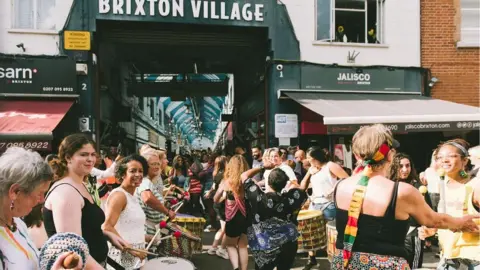 Brixton Village
Brixton VillageTurning left outside Brixton station you would be forgiven for thinking you had stepped back in time to the 1960s.
As the greengrocers bellow out the price of apples, chefs whip up a feast for eager diners, and the young and old gather together talking, dancing and shopping for everything from vinyl records to vintage clothes.
The thriving epicentre of culture, community and commerce that is Brixton Village is nothing short of electric, and the fiercely independent market has been at the heart of this multicultural community for over 160 years.
The long history of Market Row and Granville Arcade, now known as Brixton Village, has borne witness to everything from world wars to destitution and regeneration.
'South London's Oxford Street'
As Victorian Britain oversaw the rapid expansion and industrialisation of London suburbs, Brixton became the shopping capital of south London.
It was not only the sprawling outdoor street market selling fresh produce and household goods that attracted shoppers, but the first department store, the Bon Marche, built in 1877 and the first shopping street with electric lighting in 1888, Electric Avenue, ensured that Brixton established itself as a home for the middle classes and creatives including Van Gogh and Charlie Chaplin.
According to local historian and secretary at The Brixton Society, Alan Piper, "Brixton was probably South London's premier shopping destination a hundred years ago" and likened the area to Oxford Street.
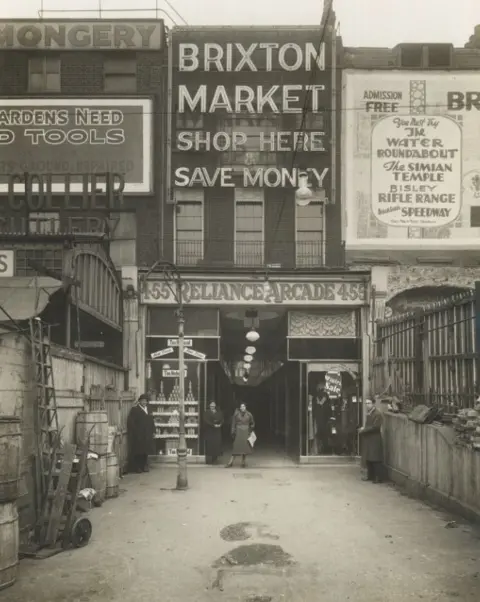 Lambeth Council
Lambeth CouncilHowever, it was not until 1937 that what is now known today as Brixton Village became Granville Arcade, named after its developer Mr Granville-Grossman.
Although during the early 1900s the market still attracted shoppers from across London thanks to the famous department stores, other suburban areas began to catch up and investment was driven away from south London's hub, often on the back of rebuilding after WW2 bomb damage.
Mr Piper said "planning blight" after the war and the closure of the Bon Marche department store significantly impacted the market's reputation.
'The market developed its soul'
Despite the lack of business investment in the market after the war, Brixton was given a new breath of life with the arrival of HMS Windrush in 1948.
According to the National Archives, there were 1,027 people on board the boat, and more than 800 of them gave their last country of residence as somewhere in the Caribbean.
In the two decades that followed, almost half a million people moved from Commonwealth countries to the UK, many of them coming from the West Indies and settling in Brixton.
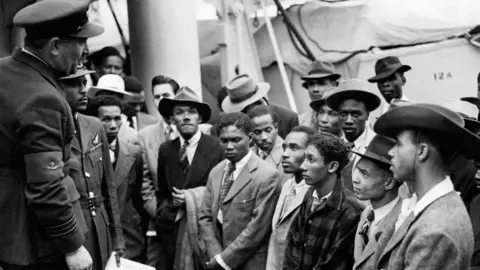 PA
PAEtta Burrell was nine years old when she arrived in Brixton with her family from Jamaica.
She recalls growing up near the market and what an important part it played in her life.
"Every Saturday my mum would put the soup on the stove in the morning and then we'd make our way down to the market.
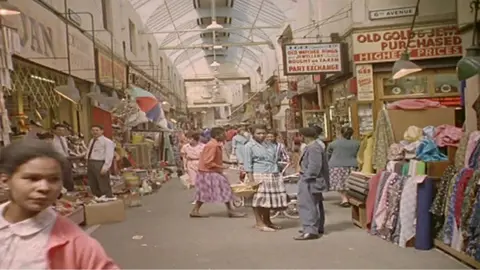 Pathe
Pathe"There was everything going on down there; there were enough theatres to rival the West End, David Bowie lived across the road, the famous Jamaican singer Alton Elllis owned the best record shop that played reggae music and the community feel was so strong.
"It felt like the market itself had a soul."
For the few decades after the war, the market flourished as it became the epicentre of multiculturalism, with shops in the village selling everything from clothes to furniture to exotic imported foods such as mangoes and sweet potatoes.
However, Mr Piper says that by the late 1960s, the market entered a period of slow decline.
"Lambeth Council had major plans to rebuild the whole town centre, but this only discouraged private investment."
He also noted a decline in the number and types of traders in the arcades due to the rise of supermarkets.
One of the country's largest Tesco stores was built in 1966 by the market and made headlines at the time for being one of the first to have a sales force, half of whom were Afro-Caribbean.
The market was further pushed into decline as tensions began to rise between local protesters and the police.
The Clash's hit 1979 song, Guns of Brixton, expressed the discontent that was building due to high unemployment, police brutality, crime and poor housing that eventually lead to the Brixton riots in the 1980s.
'Superficial' regeneration
In the 1990s, attempts were made to restore Brixton Village to its former glory, primarily through the City Challenge Programme.
The aim was for local councils to make links with businesses and put in specific bids to help regenerate town centres.
Although Lambeth Council received a large amount of funding from the government, there were few concrete results.
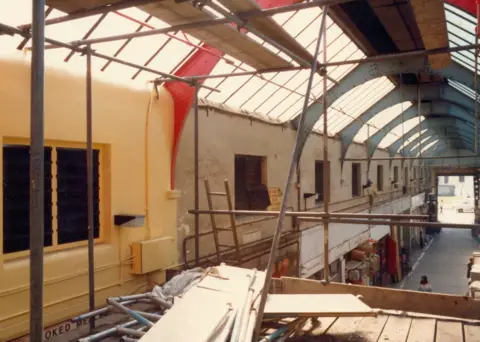 Lambeth Council
Lambeth Council"Some remodelling work was done, but I think it was only superficial redecoration and some artwork was suspended from the roofing," added Mr Piper.
Former Brixton Challenge director Mike Harry also agreed that little was achieved.
"Despite the investment, local people have not benefited, because the local communities and existing small businesses - the people who live and work in Brixton - have never been at the heart of the regeneration process."
This feeling was shared by Stafford Geohagen who came to the UK in 1999 and now runs the oldest restaurant in Brixton Village.
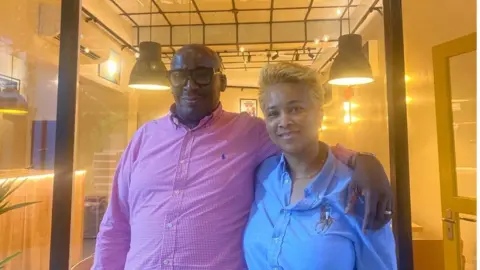
"When I first came here the market was desolate, there was nothing there and not the sort of place you would want to visit."
Stafford set up his restaurant in 2003, a time when there were "lots of empty units around me, a high turnover of businesses and no real interest in the market's development".
'Incredible transformation'
It was not until 2009 when the market had a relaunch, renaming itself as Brixton Village and providing a new offering to businesses - three months free rent on any of the units - that its fortunes changed.
Since then Stafford says the transformation of the area has been "incredible".
"This village is a melting pot of culture, people of all walks of life come together here and it has this wonderful sense of belonging and acceptance."
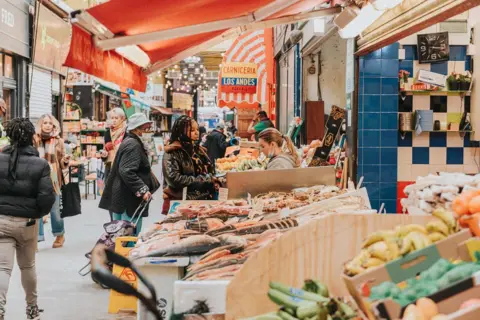 Brixton Village
Brixton VillageThe 53-year-old, who is celebrating 20 years of his restaurant, Healthy Eaters, said: "In this market we tell a story, a story through our food, music and culture. I don't see my restaurant as a place to just eat, but a place to have a experience."
The redevelopment and investment in the market has also resulted in Brixton's changing demographic which has not been viewed as wholly positive.
Etta Burrell has run her Brixton restaurant for 14 years and says that the community that existed when she was growing up has "completely disappeared".
"The area has lost its soul, things aren't the same and no one is quite as friendly anymore. It doesn't feel as warm as it did back in the day," she added.
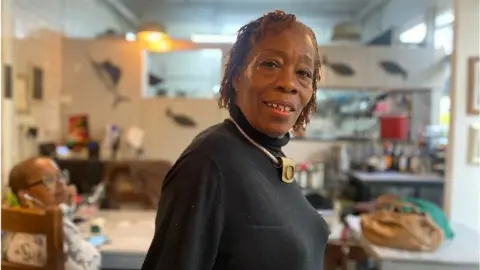
She also told the BBC that the current cost of living crisis is having an impact on vendors.
"Everything has gotten more expensive and in order to attract businesses rents need to be lower and people need to work harder together to pull through this time."
While some may say that the sense of community the market provided in its heyday is long gone, the investment into its development has never been greater.
The vibrant arcades now house more than 100 independent vendors, representing over 50 nationalities.
As Stafford sets about cooking the curry goat he will serve up this evening, he tells me that the "village has never been busier". Although it's constantly changing and is perhaps unrecognisable to what it was 70 years ago, he added: "This is my home and I will always want to be a part of it."

Listen to the best of BBC Radio London on Sounds and follow BBC London on Facebook, X and Instagram. Send your story ideas to [email protected]
